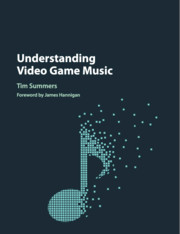Book contents
- Frontmatter
- Dedication
- Contents
- List of Figures, Musical Examples and Tables
- Foreword
- Acknowledgements
- Introduction: Beyond the Candelabrum
- PART I ANALYSING VIDEO GAME MUSIC
- PART II CRITICAL PERSPECTIVES
- 3 Texturing and the Aesthetics of Immersion
- 4 Music and Virtual Game Worlds
- 5 Communication for Play
- 6 Hollywood Film Music and Game Music
- 7 Musical Play and Video Games
- Epilogue: Fun, Play and Music
- Appendix: How to Hear a Video Game: An Outline
- Bibliography
- Ludography
- Index of Games
- General Index
3 - Texturing and the Aesthetics of Immersion
from PART II - CRITICAL PERSPECTIVES
Published online by Cambridge University Press: 05 September 2016
- Frontmatter
- Dedication
- Contents
- List of Figures, Musical Examples and Tables
- Foreword
- Acknowledgements
- Introduction: Beyond the Candelabrum
- PART I ANALYSING VIDEO GAME MUSIC
- PART II CRITICAL PERSPECTIVES
- 3 Texturing and the Aesthetics of Immersion
- 4 Music and Virtual Game Worlds
- 5 Communication for Play
- 6 Hollywood Film Music and Game Music
- 7 Musical Play and Video Games
- Epilogue: Fun, Play and Music
- Appendix: How to Hear a Video Game: An Outline
- Bibliography
- Ludography
- Index of Games
- General Index
Summary
The first part of this book discussed the practical aspects of analysing video game music. Now that we have examined the ways in which we can access and begin to investigate the musical material, we are in a position to consider critical and conceptual approaches to the music of games.
Over the following chapters, we will visit some of the most pertinent and prominent features in the critical landscape of video game music. Some of these sites of inquiry present themselves readily: the border of game music with film music, for instance, is an almost inescapable aspect of engaging with game music. Others, however, such as the notion of playfulness, require a little more theoretical legwork to access. As we traverse the conceptual topology of game music (in itself a playful exploration), we will remain grounded in the texts of video games. The games are at the heart of these discussions and rather than engaging in theoretical abstractions we will always be concerned, fundamentally, with how we can use these concepts to further understand video game music.
These chapters are, of course, a tour of the favourite sites, views, texts and obsessions of your guide-cum-narrator. But to admit my bias and forfeit any pretence at objectivity is not to discredit my arguments or choices. In fact, it bolsters them. These are the ideas and texts that have been most convincing, rewarding and useful to me, in my continuing project of understanding game music. These are the concepts that ring true for my experience of games and it would be disingenuous to claim that subjective fun, play and enjoyment should have no part in the study and discussion of game music. This is, after all, the primary reason why we engage with games. I submit my gaming/musical experience as evidence and offer these discussions as new ways to understand, and play with, our games. Disclaimers dispensed with, we begin our exploration with a concept and experience familiar to all gamers: immersion.
Immersion and Texturing
As players, we want games to be more than simply interactive. We long for those times when a game is so utterly absorbing, we lose track of time and our surroundings – we prize games that give us that rewarding sense of deep involvement in a fictional construct and gameplay mechanism.
- Type
- Chapter
- Information
- Understanding Video Game Music , pp. 57 - 84Publisher: Cambridge University PressPrint publication year: 2016
- 1
- Cited by

